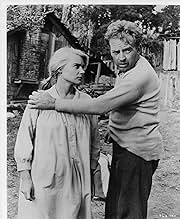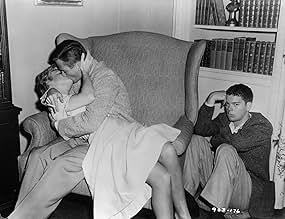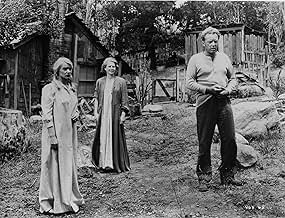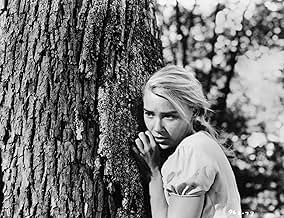IMDb RATING
7.2/10
7K
YOUR RATING
A peaceful New England town hides secrets and scandals.A peaceful New England town hides secrets and scandals.A peaceful New England town hides secrets and scandals.
- Nominated for 9 Oscars
- 2 wins & 17 nominations total
- Director
- Writers
- All cast & crew
- Production, box office & more at IMDbPro
Featured reviews
"Peyton Place" was historically very interesting cause it was virtually the first miniseries in movie theaters.After viewing it,you 've got the strange feeling of having been told ten stories or to have seen ten or twelve episodes of a miniseries.
Adapted from a bestseller which spawned a -real-TV miniseries this time- in the sixties,Dorothy Malone and Mia Farrow replacing Turner and Diane Varsi ,it is the granddaddy of the soap opera miniseries we've been seeing for all those years.Classy soap opera indeed.
Although the McKenzie (Turner and Varsi) are in the center of the plot,you can hardly call them "main characters"."Peyton Place" is made of many subplots which interfere or don't.It depicts life in a small provincial town where the main danger is gossips.The fear that" people will talk" is everywhere mainly if ,like Constance ,Serena and her mother you have secrets to conceal.Doctor Matthew Swain 's final speech deals with the talk of the town.
A soap opera maybe ,but one which depicts a not so rosy world: child abuse was not a subject movies often broached in the late fifties.My favorite scene is very short and might seem to some very down to earth: the drunkard's boy licks the home made cakes of the picnic,then stuffs himself with hot dogs and watermelon which he washed down with plenty of cola.This is not a comic relief,it makes you think:this boy is miserable,because ,even if the monster is away,he knows there's a crack in the mirror at home.Psychologically,they call that "compensation".
My favorite character is Russ Tamblyn's.Although many of the problems of PP are dated now,his is still around today: the shy boy,whose mother is over possessive ,who does believe he is "a sissy,a coward" and who thinks he will never know a girl's true love because he is too gauche.There are plenty of them even now.
Peyton Place is no masterpiece but it is really an entertaining film.
Like this?Try these....
Imitation of life Douglas Sirk 1959
Rebel without a cause Nicholas Ray 1955
Adapted from a bestseller which spawned a -real-TV miniseries this time- in the sixties,Dorothy Malone and Mia Farrow replacing Turner and Diane Varsi ,it is the granddaddy of the soap opera miniseries we've been seeing for all those years.Classy soap opera indeed.
Although the McKenzie (Turner and Varsi) are in the center of the plot,you can hardly call them "main characters"."Peyton Place" is made of many subplots which interfere or don't.It depicts life in a small provincial town where the main danger is gossips.The fear that" people will talk" is everywhere mainly if ,like Constance ,Serena and her mother you have secrets to conceal.Doctor Matthew Swain 's final speech deals with the talk of the town.
A soap opera maybe ,but one which depicts a not so rosy world: child abuse was not a subject movies often broached in the late fifties.My favorite scene is very short and might seem to some very down to earth: the drunkard's boy licks the home made cakes of the picnic,then stuffs himself with hot dogs and watermelon which he washed down with plenty of cola.This is not a comic relief,it makes you think:this boy is miserable,because ,even if the monster is away,he knows there's a crack in the mirror at home.Psychologically,they call that "compensation".
My favorite character is Russ Tamblyn's.Although many of the problems of PP are dated now,his is still around today: the shy boy,whose mother is over possessive ,who does believe he is "a sissy,a coward" and who thinks he will never know a girl's true love because he is too gauche.There are plenty of them even now.
Peyton Place is no masterpiece but it is really an entertaining film.
Like this?Try these....
Imitation of life Douglas Sirk 1959
Rebel without a cause Nicholas Ray 1955
This movie has few pretensions at being great art. Instead, it's a very glossy and high quality soap opera that deals with so many sleazy elements in an entertaining way that it will keep your attention throughout. The main theme is sex--teen sex as well as middle-aged woman sex--all in a supposedly conservative small town. It just seethes with a cauldron of rape, murder, illegitimacy and hypocrisy! You might have expected Ms. Turner instead to have done a movie akin to THE SINGING NUN after the much publicized trial, but instead chose this tell-all tale. All-in-all, an excellent movie with a great script, wonderful acting and terrific production values. However, it probably will shock you with its very frank talk about sexuality--something rarely seen in a 1950s A-picture from Hollywood.
The Hollywood melodrama is a magical thing. You could fixate on one for a century, devouring its unrealistic rosiness and torrid, intermingling plot lines. Some directors (William Wyler, Edmund Goulding) are able to nourish them, managing to turn camp into something classier than overwrought trash. But then there are others (Douglas Sirk, Billy Wilder) who can see the fun in the fluff, commenting on the usual inauthenticity while still making a top-notch product.
Peyton Place is the granddaddy of all Hollywood melodramas, not quite self-referential but not quite forgettable. It's just right. At nearly three hours, it is everything Days of Our Lives and The Bold and the Beautiful ever wanted to be. It has only three moods: romantic, stormily melodramatic, or vanilla, like Leave It to Beaver. These moods never mix together with continuity — there only seems to be room for the loudest of colors, shades and subtleties burnt to a crisp. Scenes are designed with the dramatized emphasis of a fashion magazine photoshoot, practically screaming that, yes, the film has a big-budget, and yes, it can afford to be filmed in CinemaScope.
Peyton Place isn't a smart melodrama cut from the same cloth as Written on the Wind, but thanks to shows like Twin Peaks, vintage soap has been given an entirely new edge. Instead of watching one for its unfiltered clutter, there seems to be a satirical acidity at play, even if it isn't on purpose. Landscape shots have the phony cheerfulness of a tempting postcard. Neighborhoods are decked out with white-picket fences, green grass, sunny skies, and clean-cut youths. Everything is too immaculate. You can sense that there is a lot of drama going on behind closed doors.
To explain the piling of story lines would be like patting my head and rubbing my stomach while typing; they have the same complexities as a family tree of socialites. All I will say is that Lana Turner is named Constance McKenzie (a name that was perhaps chosen by a soap opera character generator), and she, along with her daughter (Diane Varsi), acquaintances, and old-time friends, live in Peyton Place, an idyllic town stationed in rural New England. Gossip travels faster than a speeding bullet, romances begin as often as babies are born, and a scandal can destroy a person's life with more pain than a knife to the chest. I may enjoy watching tragedy happen to other people, but is it wrong to say that I would not be opposed to living in a town this exciting?
In Peyton Place, a blistery kiss or a b*tch slap to a well-endowed mug become the equivalents of a fiery explosion. It is hammier than Bette Davis eating a ham sandwich with Joan Crawford and Miriam Hopkins. There is plenty to stare at and gasp at and cry at and emote at, however ridiculous. We know that it's bad for us, but it is impossible not to consume something that wraps us up in a tweed suit and transports us into a parallel universe of cracked perfection. The youths, no matter how flawless they first appear, are either loose cannons on full throttle or suppressed lightweights waiting to blow up. The passive aggressive judgment of Peyton Place eventually sets their path and decides if they will be the talk-of-the-town for the rest of their life or the neighbor you beam at when you pass them at the grocery store.
Fittingly, the film became a hit not for its merit, not for its acting, not for its artistic capabilities, but because of a scandal possibly too jaw-dropping for the confines of Peyton Place. Long story short: At the time, Lana Turner was dating Mickey Cohen's right-hand man. One night, he flew into a rage, and, in response, her daughter came to her defense, stabbing him to death. Peyton Place had been out for months, making little money, but once the nonstop headlines began, it became the second highest grossing movie of 1958. Looking back, the Turner ordeal was and still is the kind of sh*t America feeds on with a frenzy. No one wants to admit that they enjoy some garbage here and there, but I'm sure the majority of InTouch readers indulge themselves not because they find value in celebrity gossip but because they find all the melodramatic lies to be a h*ll of a lot more entertaining than the intellect of Vanity Fair. As far as publicity goes, Peyton Place got its sharing served on a silver platter. What better suits faux soap than real soap?
Even with the unforgiving attention surrounding her, Turner has certainly never been better. Throughout the 1940s, she was mostly placed into the shoes of the sexy love interest, sometimes a femme fatale and sometimes the sweet girl you can't wait to go home to after fighting overseas. In Peyton Place, she is appealingly breathy, always ready with cocked eyebrow, perpetually p*ssed off at how her messy past affects her currently dusty one. She blows cigarette smoke as if she's late for an upcoming confrontation with an old mistake. Turner carries the weight of the film on her shoulders, working as its emotional core and its best actor. Some could declare her work as pure overacting, but on Peyton Place's terms, she comes out a champion. Few can say that murder lead to their career resurgence, but Turner is more than able.
One could accuse Peyton Place of being too preachy to be completely successful, but its influence is undeniable. It propelled the careers of talented young actors (Russ Tamblyn, Hope Lange), and lead to a popular TV spin-off in the 1960s, setting the standard for modern soap operas. As a standalone film, it works as a well-made, wildly entertaining soaper. The two-hours and 37 minutes go by with lightning speed; one could say that the film is too short, a good sign if there ever was one.
Peyton Place is the granddaddy of all Hollywood melodramas, not quite self-referential but not quite forgettable. It's just right. At nearly three hours, it is everything Days of Our Lives and The Bold and the Beautiful ever wanted to be. It has only three moods: romantic, stormily melodramatic, or vanilla, like Leave It to Beaver. These moods never mix together with continuity — there only seems to be room for the loudest of colors, shades and subtleties burnt to a crisp. Scenes are designed with the dramatized emphasis of a fashion magazine photoshoot, practically screaming that, yes, the film has a big-budget, and yes, it can afford to be filmed in CinemaScope.
Peyton Place isn't a smart melodrama cut from the same cloth as Written on the Wind, but thanks to shows like Twin Peaks, vintage soap has been given an entirely new edge. Instead of watching one for its unfiltered clutter, there seems to be a satirical acidity at play, even if it isn't on purpose. Landscape shots have the phony cheerfulness of a tempting postcard. Neighborhoods are decked out with white-picket fences, green grass, sunny skies, and clean-cut youths. Everything is too immaculate. You can sense that there is a lot of drama going on behind closed doors.
To explain the piling of story lines would be like patting my head and rubbing my stomach while typing; they have the same complexities as a family tree of socialites. All I will say is that Lana Turner is named Constance McKenzie (a name that was perhaps chosen by a soap opera character generator), and she, along with her daughter (Diane Varsi), acquaintances, and old-time friends, live in Peyton Place, an idyllic town stationed in rural New England. Gossip travels faster than a speeding bullet, romances begin as often as babies are born, and a scandal can destroy a person's life with more pain than a knife to the chest. I may enjoy watching tragedy happen to other people, but is it wrong to say that I would not be opposed to living in a town this exciting?
In Peyton Place, a blistery kiss or a b*tch slap to a well-endowed mug become the equivalents of a fiery explosion. It is hammier than Bette Davis eating a ham sandwich with Joan Crawford and Miriam Hopkins. There is plenty to stare at and gasp at and cry at and emote at, however ridiculous. We know that it's bad for us, but it is impossible not to consume something that wraps us up in a tweed suit and transports us into a parallel universe of cracked perfection. The youths, no matter how flawless they first appear, are either loose cannons on full throttle or suppressed lightweights waiting to blow up. The passive aggressive judgment of Peyton Place eventually sets their path and decides if they will be the talk-of-the-town for the rest of their life or the neighbor you beam at when you pass them at the grocery store.
Fittingly, the film became a hit not for its merit, not for its acting, not for its artistic capabilities, but because of a scandal possibly too jaw-dropping for the confines of Peyton Place. Long story short: At the time, Lana Turner was dating Mickey Cohen's right-hand man. One night, he flew into a rage, and, in response, her daughter came to her defense, stabbing him to death. Peyton Place had been out for months, making little money, but once the nonstop headlines began, it became the second highest grossing movie of 1958. Looking back, the Turner ordeal was and still is the kind of sh*t America feeds on with a frenzy. No one wants to admit that they enjoy some garbage here and there, but I'm sure the majority of InTouch readers indulge themselves not because they find value in celebrity gossip but because they find all the melodramatic lies to be a h*ll of a lot more entertaining than the intellect of Vanity Fair. As far as publicity goes, Peyton Place got its sharing served on a silver platter. What better suits faux soap than real soap?
Even with the unforgiving attention surrounding her, Turner has certainly never been better. Throughout the 1940s, she was mostly placed into the shoes of the sexy love interest, sometimes a femme fatale and sometimes the sweet girl you can't wait to go home to after fighting overseas. In Peyton Place, she is appealingly breathy, always ready with cocked eyebrow, perpetually p*ssed off at how her messy past affects her currently dusty one. She blows cigarette smoke as if she's late for an upcoming confrontation with an old mistake. Turner carries the weight of the film on her shoulders, working as its emotional core and its best actor. Some could declare her work as pure overacting, but on Peyton Place's terms, she comes out a champion. Few can say that murder lead to their career resurgence, but Turner is more than able.
One could accuse Peyton Place of being too preachy to be completely successful, but its influence is undeniable. It propelled the careers of talented young actors (Russ Tamblyn, Hope Lange), and lead to a popular TV spin-off in the 1960s, setting the standard for modern soap operas. As a standalone film, it works as a well-made, wildly entertaining soaper. The two-hours and 37 minutes go by with lightning speed; one could say that the film is too short, a good sign if there ever was one.
Okay, so I wasn't alive in the 50s. But my father certainly was.
He recommended this movie to me, and I have to say -- I was impressed.
It represents one of the few mainstream films of the era that presented day-to-day life as it really was. Peyton Place is a movie that strips away the candy-coated exterior which surrounds many a 50s film, and shows the raw and flawed lives of people who are struggling with issues that viewers in today's society can still relate to.
Although a different genre, it wasn't until I delved deeper into Film Noir that I discovered more films that presented an edgier and raw window into the world of the 40s and 50s. I appreciate a writer or director that has the guts to risk losing viewers by insisting on honest presentation of culture or events.
This film is worth a look.
He recommended this movie to me, and I have to say -- I was impressed.
It represents one of the few mainstream films of the era that presented day-to-day life as it really was. Peyton Place is a movie that strips away the candy-coated exterior which surrounds many a 50s film, and shows the raw and flawed lives of people who are struggling with issues that viewers in today's society can still relate to.
Although a different genre, it wasn't until I delved deeper into Film Noir that I discovered more films that presented an edgier and raw window into the world of the 40s and 50s. I appreciate a writer or director that has the guts to risk losing viewers by insisting on honest presentation of culture or events.
This film is worth a look.
When I saw "Peyton Place" recently on AMC for the first time, my thought was: "This is it? This is what drove the puritans into a foaming frenzy 42 years ago? There's more filth and dirt in the dumpster!" While it's true that the world has taken more than a few spins since 1957, and while it's true that the film tends to date a bit, "Peyton Place" is still, at it's best, top-notch entertainment.
Lana Turner, in what was, regrettably, her only Oscar-nomination, scores solidly as the pivotal character of Constance McKenzie. Diane Varsi, whose life and career would go out of control soon after (remember "Wild in the Streets?"), is equally compelling as Allyson McKenzie, her daughter. Arthur Kennedy lends his usual understated but powerful presence to the principal heavy of the piece, Lucas Cross, and the young Hope Lange, whom a later generation probably remembers best for TV's "The Ghost and Mrs. Muir," gives a solid performance as Selena Cross, the girl with a secret from the wrong side of the tracks. Others in the notable cast include such reliable performers as Lloyd Nolan, Russ Tamblyn, Betty Field, and a two years pre - "Bonanza" Lorne Greene, all turning in fine performances.
If you can, see this film in letterbox, if only for the beautiful Camden, Maine, scenery, beautifully captured by William C. Mellor's cameras. And, if you don't think this film's been influential, look at all it's successors, including the only TV series ever to have been on three times a week during the '60's, and today's "Dawson's Creek" and "Melrose Place." Here's the film that started it all, though, and it's still solid entertainment, especially if you put yourself in a late-'50's mindset while watching it.
Lana Turner, in what was, regrettably, her only Oscar-nomination, scores solidly as the pivotal character of Constance McKenzie. Diane Varsi, whose life and career would go out of control soon after (remember "Wild in the Streets?"), is equally compelling as Allyson McKenzie, her daughter. Arthur Kennedy lends his usual understated but powerful presence to the principal heavy of the piece, Lucas Cross, and the young Hope Lange, whom a later generation probably remembers best for TV's "The Ghost and Mrs. Muir," gives a solid performance as Selena Cross, the girl with a secret from the wrong side of the tracks. Others in the notable cast include such reliable performers as Lloyd Nolan, Russ Tamblyn, Betty Field, and a two years pre - "Bonanza" Lorne Greene, all turning in fine performances.
If you can, see this film in letterbox, if only for the beautiful Camden, Maine, scenery, beautifully captured by William C. Mellor's cameras. And, if you don't think this film's been influential, look at all it's successors, including the only TV series ever to have been on three times a week during the '60's, and today's "Dawson's Creek" and "Melrose Place." Here's the film that started it all, though, and it's still solid entertainment, especially if you put yourself in a late-'50's mindset while watching it.
Did you know
- TriviaSome of the shots of the New England fall were shot for Mais qui a tué Harry? (1955).
- GoofsAll of the women's hair styles and clothing are strictly 1957, not 1941.
- Quotes
Mr. Harrington: This job starts at 3,000 a year.
Michael Rossi: Then we're all wasting our time. That's only $5 a week more than I was making as a teacher, Mr. Harrington
Mr. Harrington: But this offers you security -- a long term contract.
Michael Rossi: Guaranteed poverty is not security.
- Alternate versions(Spoiler) Originally premiered at 162 minutes. Cut by 5 minutes, shortly after premiere, reputedly in the scene involving the murder of Arthur Kennedy's character.
- ConnectionsFeatured in 20th Century-Fox: The First 50 Years (1997)
- SoundtracksWonderful Season of Love (Theme from Peyton Place)
(uncredited)
Music by Franz Waxman
Lyrics by Paul Francis Webster
[Sung by chorus over closing credits]
- How long is Peyton Place?Powered by Alexa
Details
- Release date
- Country of origin
- Official site
- Language
- Also known as
- Peyton Place
- Filming locations
- Camden, Maine, USA(Exterior)
- Production companies
- See more company credits at IMDbPro
Box office
- Gross US & Canada
- $25,600,000
- Runtime2 hours 37 minutes
- Color
- Aspect ratio
- 2.35 : 1
Contribute to this page
Suggest an edit or add missing content

Top Gap
By what name was Les Plaisirs de l'enfer (1957) officially released in India in English?
Answer


































